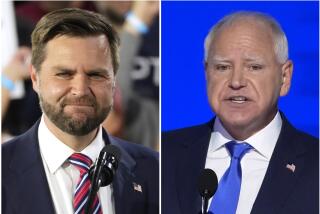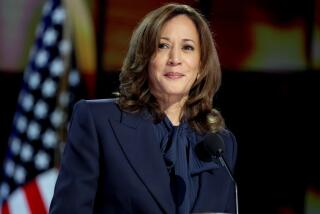Staying Ahead Is Vital
- Share via
ALEXANDRIA, VA. — Texas Gov. George W. Bush still maintains his advantage over Vice President Al Gore: The most recent Los Angeles Times Poll shows Bush leading 50%-40%. Meanwhile, the Gore campaign continues to struggle internally, with personnel shake-ups and policy redirection. Commerce Secretary William H. Daley’s move into the inner circle means perhaps two to three weeks of real chaos, as Daley’s team assimilates the structure and makes additional changes during the critical time leading up to the Democratic convention in Los Angeles.
On July 31, the Republican National Convention opens in Philadelphia, and the nation will have an opportunity to view Bush accepting his party’s nomination. What factors will contribute to a successful convention?
The Bush team has made it clear that the convention is an opportunity to create 12 to 14 days of news dominance--pre-convention, during the meeting and post-convention--to further bolster Bush.
The first factor for measuring the success of the Bush effort is management of the platform. This will take place July 28-29, the Friday and Saturday before the convention starts. Wisconsin Gov. Tommy G. Thompson, who chairs the platform committee, has already held meetings with both pro-choice and antiabortion forces. Thompson has made it clear that the party’s abortion platform will not change, while Bush has insisted he will not use abortion as a litmus test to select Supreme Court justices. At this time, the abortion issue does not appear to be a problem for Bush, and the GOP has consolidated behind him.
Second is Bush’s choice for vice president. The national media will be focused on this decision and will compare it with his father’s choice of J. Danforth Quayle. Bush’s criteria are simple: a person prepared to be president, loyal to Bush, with whom he feels personal chemistry and who can further the ticket’s appeal to critical swing voters. These factors certainly do not prohibit a pro-choice pick.
Third is Bush’s performance Thursday evening, when he delivers his acceptance speech before a national TV audience. Remember, in 1988, Vice President George Bush delivered a terrific speech that changed the dynamic of the race and placed Michael S. Dukakis on the defensive. George W. Bush must demonstrate leadership, emphasize values important to him in defining what it means to be a compassionate conservative and show voters that he possesses presidential gravitas.
Immediately after Bush’s address, the national media will make their pronouncements about the convention and the ticket. For the Bush team, the mark of success will be the generation of an energy level that creates a halo effect and “convention bounce” in polling numbers leading into the Democratic convention. Look also for news buzz created by speakers such as Colin L. Powell, Sen. John McCain of Arizona, Elizabeth H. Dole and perhaps the governor’s nephew, George P. Bush, the family’s most telegenic member, who also greatly appeals to the Latino community.
In addition, the governor’s strategic team has sent signals that it is not going to be locked into the paradigm of past conventions, when one evening was devoted to attacking the Democratic nominee. This is an interesting departure and not without risk. But the voter groups most crucial for Bush--women, seniors, Latinos, moderates, suburbanites--largely reject negative campaign tactics. By staying positive throughout the convention, Bush will force the media to cover his strategy extensively. He also will test Gore’s resolve to go negative against Bush, which he is clearly comfortable doing, and thus risk alienating voter groups he needs.
Bush’s success, so far, can be attributed to the three Ps: policy, personality and partisanship. He has spent the spring and early summer delivering significant policy speeches on education, health care, housing, Social Security and missile defense. His perceptual ratings remain significantly more favorable than Gore’s, and he is offering a new face for the GOP with his compassionate conservatism and positive campaign style. The Republican base is solidly behind him, though he still needs the GOP congressional leadership to stay out of the limelight and avoid actions that could be detrimental to his efforts.
Gore, too, has numerous convention challenges; his team was battle-tested in the 1992 and 1996 skirmishes. At some point, however, Gore must cut into Bush’s lead and change the dynamic. It’s clear that Bush is doing everything in his power to continue to control the agenda, define the race and not concede any issue or opportunities.
The next important variable to measure is the presidential ballot test at the end of August, after both parties have concluded their convention. If Bush still maintains his lead, then he will have won the month of August and start the general-election sprint on offense. So far, Bush has shown he has the stamina for such a marathon. *
More to Read
Get the L.A. Times Politics newsletter
Deeply reported insights into legislation, politics and policy from Sacramento, Washington and beyond. In your inbox twice per week.
You may occasionally receive promotional content from the Los Angeles Times.










